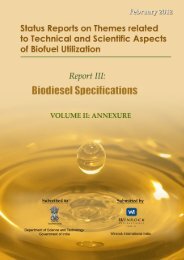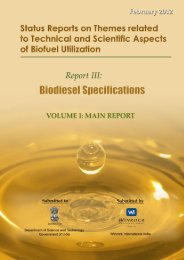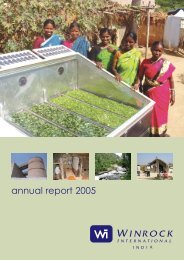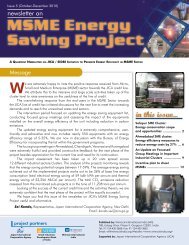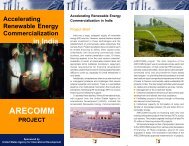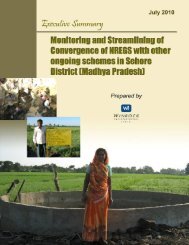IssuE 8 â ApRIl â JuNE 2011 - Winrock International India
IssuE 8 â ApRIl â JuNE 2011 - Winrock International India
IssuE 8 â ApRIl â JuNE 2011 - Winrock International India
Create successful ePaper yourself
Turn your PDF publications into a flip-book with our unique Google optimized e-Paper software.
field experience<br />
for fuel dilemma, since less land<br />
is available for agricultural food<br />
production.<br />
One potential solution to avoid this<br />
problem is the establishment of<br />
agro-forestry systems on land that is<br />
unsuitable for agricultural production,<br />
such as salt-affected soils. Worldwide,<br />
933 million hectares of land are<br />
badly degraded by salts and cannot<br />
be productively used for traditional<br />
agriculture. More than 8 million<br />
hectares of previously productive land<br />
in <strong>India</strong> is now salt affected. These<br />
huge tracts of land can potentially be<br />
used to grow fast-growing salt-tolerant<br />
tree species that can be used for a<br />
variety of energy and other products.<br />
This study reviewed in this article has<br />
focused on the economic feasibility<br />
and socio-economic effects of working<br />
bio-saline agro-forestry systems in<br />
Haryana, <strong>India</strong>. The socio-economic<br />
effects constitute of potential benefits<br />
to the farmers and other actors that<br />
may come from the use of agroforestry<br />
systems. These benefits<br />
include, for example, extra income,<br />
higher yields, higher employment and<br />
more divers products from the land<br />
(fuel wood, fodder etc.). In line with<br />
this stands the economic feasibility<br />
of these systems, if the system<br />
is not viable it will not have any<br />
benefit to the farmers and users and<br />
implementation of the system will not<br />
be successful.<br />
energy and processing) to produce a<br />
unit of output product (ton or kWh).<br />
These data are used for the calculation<br />
of the Net Present Value (NPV) and<br />
cost of production (COP) of the<br />
produced products.<br />
The plantations were established as<br />
part of the Haryana Social Forestry<br />
Project. Through this program, the<br />
state government is encouraging<br />
the establishment of agro-forestry<br />
plantations on salt-affected Panchayat<br />
lands. The initial cost of plantation<br />
establishment and maintenance in<br />
the first three years is financed by the<br />
government. The benefits of selling<br />
the trees or using the trees in the<br />
community are allocated entirely to<br />
the Panchayat. This can potentially<br />
make agro-forestry very lucrative<br />
for the local communities. The case<br />
studies plantations were all established<br />
under this project. In Haryana, a<br />
survey was conducted in four villages<br />
(Figure 1) to determine the inputs<br />
needed to maintain and harvest the<br />
agro-forestry system present, as<br />
well as the annual and total biomass<br />
yields. Prior to plantations, all land<br />
was highly alkaline in nature and<br />
no traditional agriculture could be<br />
performed (Figure 2 on next page).<br />
The land was essentially a wasteland<br />
and only scarce vegetation such<br />
as grasses and some Acacia nilotica<br />
were present. The land was used for<br />
fuelwood collection and grazing of<br />
livestock. Table 1 (next page) gives a<br />
quick overview of the specifics of each<br />
plantation that was established in<br />
each individual village. Figure 3 (next<br />
page) shows an example of a biosaline<br />
plantation at the Central Soil<br />
Salinity Institute (CSSRI) in Karnal.<br />
Each output product requires a<br />
different amount of processing before<br />
the finished product can be used or<br />
sold to the market. In addition to<br />
surveying the villages for the biomass<br />
production phase, several processing<br />
facilities were visited with the aim to<br />
establish the inputs and outputs to get<br />
The aim of the study was to construct<br />
and analyze three value chains that<br />
are derived from the bio-saline agroforestry<br />
plantations. Every value chain<br />
begins with the biomass production<br />
phase and has three different output<br />
products. These are fuelwood, timber,<br />
and charcoal. The analysis includes all<br />
inputs (costs, labour, transportation,<br />
Figure 1: Case study locations in the state of Haryana. (source: Stille et al, <strong>2011</strong>)<br />
April-June <strong>2011</strong><br />
31




